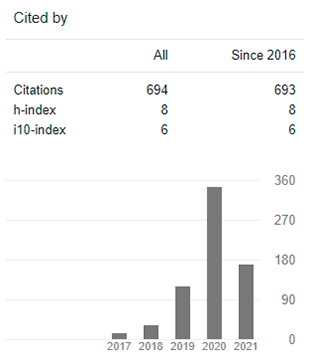Universal single digital medical record in Peru: from chaos to order in medical information
DOI:
https://doi.org/10.29394/Scientific.issn.2542-2987.2022.7.24.4.78-95Keywords:
clinic history, electronic history, digital historyAbstract
The traditional Clinical Record, the one written on paper, little by little loses validity and in its replacement, the Electronic Clinical Record has been consolidating within the health community; its peculiarities and characteristics have played a decisive role in making its use more important in most health providers. The path and qualities of the Electronic Medical Record are entangled when it is observed that each provider uses a different platform for the collection of medical information and this condition reduces the use of information and its interoperability in various healthcare entities in front of to the need of the emergency. This article sought to collect information on the progress in the various latitudes regarding the issue and in this sense verified how Europe already has a long path walked; while in Latin America and Peru we still use dissimilar formats, the closest thing to an attempt to unify platforms. The main conclusion is the need for Peru to design and implement the Unique and Universal Digital Medical Record and become a pioneer in the use of the format that interoperates medical information throughout the region. This study is considered to have bibliographic, theoretical and descriptive characteristics, whose procedure includes the search, organization, systematization and analysis of a set of digital documents, the subject is the generalization of medical records, unique medical records and summaries 2014-2021. digital medical records. All information on the above topics found in databases such as Latindex, SciELO, Elsevier, etc. are considered as search and analysis units.
Downloads
References
Abad, I., Giménez, J., Etreros, J., Muñoz, J., & Vaquerizo, C. (2009). Algunas consideraciones sobre seguridad de la información en el proyecto europeo de historia clínica digital (Proyecto EPSOS). DS: Derecho y salud, 18(01), 87-98, e-ISSN: 1133-7400. Recuperado de: https://dialnet.unirioja.es/servlet/articulo?codigo=3016235
Alcaraz, M., Nápoles, Y., Chaveco, I., Martínez, M., & Coello, J. (2010). La historia clínica: un documento básico para el personal médico. MEDISAN, 14(7), 1-7, e-ISSN: 1029-3019. Recuperado de: http://scielo.sld.cu/scielo.php?script=sci_arttext&pid=S1029-30192010000700018
Atienza, O. (2013a,b). Historia Clínica Informática Única, una herramienta en la mejora de los procesos de salud pública. Tesis. Córdova, España: Universidad de Córdova.
Blobel, B., & Giacomini, M. (2021). Proceedings of the 18th International Conference on Wearable Micro and Nano Technologies for Personalized Health. ISBN: 978-1-64368-226-6. Europa: IOS Press BV.
Canales, A., Huapaya, O., Chuco, M., Mendoza, J., & Sinti, W. (2016). Implementación de historia clínica electrónica en la Clínica Bellavista-Auna. Tesis. Lima, Perú: Universidad San Ignacio de Loyola.
Cuenca, G., & Salvador, J. (2017). Representación del conocimiento en historia clínica electrónica interoperable. El caso de la Historia Clínica Digital del Sistema Nacional de Salud de España. Scire: Representación y organización del conocimiento, 23(1), 25-38, e-ISSN: 1135-3716. Recuperado de: https://dialnet.unirioja.es/servlet/articulo?codigo=6046576
CSP (2014). Período Anual de Sesiones 2013-2014. Predictamen - 2013-2014/CSP-CR. Perú: Comisión de Salud y Población.
EDPB (2019). Dictamen conjunto 1/2019 del CEPD-SEPD sobre el tratamiento de datos de los pacientes y el papel de la Comisión Europea dentro la infraestructura de servicios digitales de sanidad electrónica (eHDSI, por sus siglas en inglés). Bruselas, Bélgica: Comité Europeo de Protección de Datos.
EsSalud (2019). EsSalud implementa historia clínica digital para atención de asegurados. Perú: Seguro Social de Salud.
Gonzalez-Argote, J. (2019). La producción científica latinoamericana sobre historia clínica digital: un análisis desde Scopus. Revista Cubana de Salud Pública, 45(3), 1-15, e-ISSN: 1561-3127. Cuba: Editorial Ciencias Médicas.
Gonzales, R., & Cardentey, J. (2015a,b). La historia clínica médica como documento médico legal. Revista Médica Electrónica, 37(6), 648-653, e-ISSN: 1684-1824. Matanzas, Cuba: Centro Provincial de Información de Ciencias Médicas.
MINSA (2020a,b). Compendio de Normas Minsa. Perú: Ministerio de Salud de Perú - OGTI -Biblioteca y BVS.
Moharra, M., Almazán, C., Rúbies, C., & Gallego, C. (2011a,b,c). Les TIC i el projecte epSOS: disseny d’un marc d’avaluació. Annals de Medicina, 94(3), 119-123, e-ISSN: 2013-7109. Recuperado de: http://hdl.handle.net/11351/3329
Remedi, M. (2017a,b). Sistema de Acceso a Resumen de Historia Clínica Digital de Pacientes. Tesis. Argentina: Universidad Siglo 21. Recuperado de: https://repositorio.uesiglo21.edu.ar/handle/ues21/13889
Rendón, I., Ruiz, D., Suárez, V., & Prieto, J. (2018). Historias clínicas digitales desde la perspectiva colombiana: seguridad, calidad y gestión del dato. Inventum, 13(24), 22-28, e-ISSN: 2590-8219. Recuperado de: https://doi.org/10.26620/uniminuto.inventum.13.24.2018.22-28
Downloads
Published
How to Cite
Issue
Section
License
Copyright (c) 2022 INDTEC, C.A.

This work is licensed under a Creative Commons Attribution-NonCommercial-ShareAlike 4.0 International License.
The content of the journals of this site, are under a Creative Commons Attribution-Noncommercial-Share Alike 4.0 International License.













